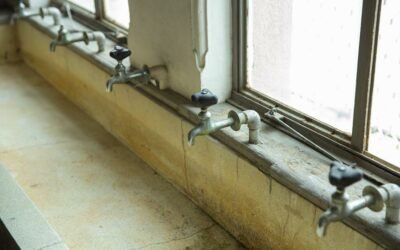Are you concerned about the possibility of mold growing in your insulation?
In this article, we will explore the factors that promote mold growth in insulation and provide you with warning signs to look out for.
Additionally, we will discuss preventive measures you can take to control mold growth and effective techniques for mold remediation in insulation.
By understanding these important aspects, you can ensure a healthy and mold-free environment in your home.
Key Takeaways
- Mold growth in insulation can compromise indoor air quality and cause respiratory issues and allergies.
- Factors promoting mold growth in insulation include poor ventilation, water leaks, condensation, and excessive moisture.
- Warning signs of mold in insulation include a musty odor, allergic reactions or respiratory issues, discoloration or staining on the insulation, and visible patches of mold growth.
- Preventive measures for controlling mold in insulation include regular inspections, proper ventilation, controlling humidity levels, and proper cleaning and maintenance techniques.
Common Concerns About Mold in Insulation
If you're worried about mold in insulation, there are several common concerns to consider.
Mold growth in insulation can occur when there's excessive moisture present. Insulation materials such as fiberglass, cellulose, or foam can provide a suitable environment for mold to grow if the conditions are right.
One concern is that mold in insulation can compromise the indoor air quality of your home. When mold spores are released into the air, they can cause respiratory issues and allergies in individuals who are sensitive to them.
Another concern is that mold growth in insulation can lead to structural damage. Mold can weaken the structural integrity of the insulation, causing it to deteriorate over time.
Additionally, mold in insulation can spread to other areas of your home, potentially causing damage to walls, ceilings, and other surfaces.
To prevent mold growth in insulation, it's important to address any sources of moisture in your home, such as leaks or excessive humidity. Regular inspections and maintenance can help identify and address any potential issues before they become a problem.
Factors That Promote Mold Growth in Insulation
Excessive moisture is one of the main factors that can promote mold growth in insulation. When moisture levels are too high, it creates an ideal environment for mold spores to thrive and multiply. However, moisture alone isn't the only factor that can contribute to mold growth in insulation. There are several other factors that can also play a role in promoting mold growth.
Here are three key factors that can promote mold growth in insulation:
- Poor ventilation: Insulation that isn't properly ventilated can trap moisture and humidity, creating a damp environment that's conducive to mold growth.
- Water leaks: If there are any water leaks in the building, it can result in moisture accumulating in the insulation. This can provide the necessary conditions for mold to grow and spread.
- Condensation: When warm air comes into contact with cooler surfaces, condensation can occur. If this happens within the insulation, it can lead to moisture buildup and mold growth.
It is important to address these factors to prevent mold growth in insulation. Proper ventilation, regular inspections for water leaks, and addressing condensation issues can help maintain a mold-free environment. By taking these preventive measures, you can ensure that your insulation remains dry, clean, and free from mold.
Warning Signs of Mold in Insulation
You may notice visible patches of mold growing on your insulation. Mold thrives in environments that are damp and dark, making insulation a prime breeding ground. However, it isn't always easy to detect mold in insulation, as it's often hidden behind walls or in attics and crawl spaces. Nevertheless, there are some warning signs that can indicate the presence of mold in your insulation.
One of the most common signs of mold in insulation is a musty or unpleasant odor. If you notice a strong, persistent smell coming from your walls or ceilings, it could be a sign of mold growth.
Additionally, if you or your family members experience unexplained allergic reactions or respiratory issues, it could be a result of mold spores being released into the air from contaminated insulation.
Another warning sign is discoloration or staining on the surface of the insulation. Mold often appears as black, green, or brown patches on insulation materials. If you see any visible signs of mold growth on your insulation, it's important to take immediate action to prevent further contamination and potential health risks.
Preventive Measures for Controlling Mold in Insulation
To effectively control mold growth in insulation, it's important to regularly inspect and maintain your insulation using proper cleaning and ventilation techniques. Mold can thrive in damp and humid environments, so taking preventive measures is crucial to minimize the risk of mold growth in your insulation.
Here are some key steps you can take:
- Inspect your insulation regularly: Regularly check your insulation for any signs of moisture, leaks, or water damage. Addressing these issues promptly can prevent mold growth.
- Ensure proper ventilation: Proper ventilation is essential in preventing mold growth. Make sure that your attic, crawl spaces, and other areas with insulation are well-ventilated to allow for proper airflow and moisture control.
- Control humidity levels: High humidity levels can create a favorable environment for mold growth. Use dehumidifiers or air conditioners to maintain optimal humidity levels in your home, typically between 30% and 50%.
Mold Remediation Techniques for Insulation
One effective way to address mold growth in insulation is by implementing proper remediation techniques. Mold remediation refers to the process of removing mold and preventing its regrowth. When it comes to insulation, there are several techniques that can be employed to effectively deal with mold contamination.
Firstly, it's important to identify the source of moisture that's causing the mold growth in the insulation. This could be due to a leaky roof, plumbing issues, or poor ventilation. Once the source is identified and repaired, the next step is to remove the affected insulation. This can be done by cutting out the contaminated sections and disposing of them properly. It's crucial to wear personal protective equipment, such as gloves and a respirator, to avoid inhalation of mold spores during the removal process.
After the removal of the contaminated insulation, the affected area should be thoroughly cleaned and dried. This may involve using a HEPA vacuum to remove any remaining mold spores, followed by wiping the area with a biocide solution to kill any remaining mold. It's important to ensure that the area is completely dry before installing new insulation to prevent future mold growth.
Conclusion
In conclusion, mold can indeed grow in insulation under certain conditions. Factors such as high humidity, water leaks, and poor ventilation can promote mold growth in insulation.
It's important to be aware of warning signs such as musty odors, discoloration, or visible mold growth in insulation. Taking preventive measures such as maintaining proper ventilation and addressing any moisture issues can help control mold growth.
In cases where mold is present, professional mold remediation techniques should be employed to ensure effective removal.






0 Comments